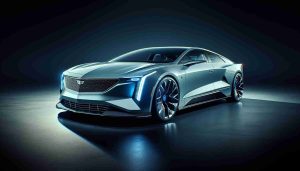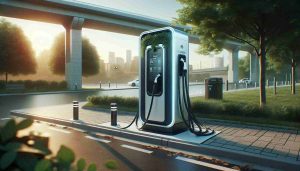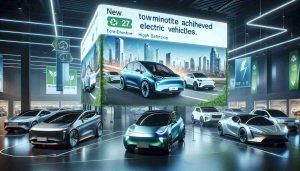Revolutionary Solar Power Shines in Remote Australia! Can You Believe What They’re Charging?

Remote Solar Array Lights Up EV Charging in Northern Australia
Powerhouse has undertaken a groundbreaking project in the isolated Whim Creek Hotel, located 1,639 km northeast of Perth. They have successfully installed a 60 kVA off-grid solar array designed to power an electric vehicle (EV) charger, marking a significant step forward in the 7,000 km Western Australia (WA) EV Network initiative.
This innovative solar installation includes JinkoSolar panels and a sophisticated array of SMA and Victron Quattro inverters. Together, these components facilitate charging capabilities for a 50 kW EV charger, which can be upgraded to a more powerful 75 kW fast charger. This station forms part of an extensive plan involving 110 fast chargers across 49 locations helmed by Horizon Power.
To ensure efficient operation despite extreme temperatures nearing 50°C, the Powerhouse teams executed the installation overnight. The project involved installing a 106-module solar system and overcoming the challenges posed by the harsh environment and remote location.
The efforts don’t stop at Whim Creek; they have also launched another EV charger at the Mundrabilla Roadhouse situated 1,361 km east of Perth. These additions enhance the WA EV Network, which aims to be the longest electric vehicle charging route in Australia, connecting vast stretches of asphalt and promoting sustainable travel across the region.
Powering the Future: The Broader Impact of Renewable Energy on Australia’s EV Landscape
The initiative undertaken at the Whim Creek Hotel underscores a broader transformation within Australia’s approach to energy and transportation. As electric vehicle (EV) adoption accelerates globally, infrastructure development becomes crucial. This project not only introduces off-grid solar technology but also embodies a shift toward sustainable travel, which can reshape societal behaviors and cultural attitudes towards renewable energy.
The integration of solar power into EV charging infrastructure could catalyze a significant transformation in the global economy. As Australia enhances its EV network, it creates a model that could inspire other nations, particularly those with vast unpopulated areas. By deploying off-grid solutions, regions can reduce reliance on fossil fuels, potentially lowering energy costs and generating new jobs in renewable technologies.
Furthermore, the environmental implications are profound. A rise in solar-powered EV chargers contributes to decreased carbon emissions, aligning with global sustainability goals outlined in the Paris Agreement. As more remote locations gain access to clean energy resources, the long-term significance is clear: a concerted effort toward an eco-friendly future.
Looking to the future, the trend towards integrating renewable energy with transportation will likely become more pronounced. With advances in technology, efficiency improvements and cost reductions for solar installations and EV infrastructure will pave the way for a fully sustainable transportation system that can thrive in even the most challenging environments. Australia is poised to take the lead in this arena, setting a precedent for others to follow.
Revolutionizing EV Charging: How Solar Innovations Are Lighting Up Remote Australia
Remote Solar Array Lights Up EV Charging in Northern Australia
In a significant leap towards sustainable travel, Powerhouse has recently completed a pioneering project at the Whim Creek Hotel in Northern Australia. This ambitious initiative features a 60 kVA off-grid solar array that powers an electric vehicle (EV) charger, part of the extensive 7,000 km Western Australia (WA) EV Network.
# Key Features of the Project
This innovative solar installation harnesses the latest technology, including JinkoSolar panels paired with advanced SMA and Victron Quattro inverters. Together, these components provide charging capabilities for a 50 kW EV charger, with the possibility of upgrading to a 75 kW fast charger. This station contributes to a larger conversation about sustainable energy solutions, making EV charging more accessible to remote areas.
# Installation Challenges and Solutions
Setting up this solar array was not without its challenges. The installation faced extreme temperatures, occasionally soaring to 50°C. The Powerhouse teams adapted by conducting the installation work overnight, ensuring worker safety and system efficiency. The final setup consists of 106 solar modules, strategically arranged to optimize sunlight capture despite the harsh environment.
# Expansion of the WA EV Network
But Whim Creek is just one piece of the puzzle. Powerhouse has also launched another EV charger at the Mundrabilla Roadhouse, located 1,361 km east of Perth. These chargers are crucial components of the WA EV Network, which aims to establish the longest electric vehicle charging route in Australia. With plans for 110 fast chargers across 49 strategic locations, this network will significantly enhance travel routes for electric vehicles in Western Australia.
Market Analysis and Future Trends
As the adoption of electric vehicles accelerates, the demand for reliable EV charging infrastructure becomes increasingly vital. The integration of renewable energy sources, such as solar power, in remote areas is a forward-thinking approach that aligns with global sustainability goals. Analysts predict that as technology continues to innovate, the availability of solar-powered charging stations will expand, fostering more widespread EV adoption and promoting cleaner transportation options.
Pros and Cons of Solar-Powered EV Charging
Pros:
– Sustainability: Utilizes renewable resources, reducing reliance on fossil fuels.
– Cost-Effectiveness: Long-term savings on energy costs by using solar power.
– Accessibility: Provides charging options in remote areas where electricity infrastructure may be lacking.
Cons:
– Initial Costs: High upfront investments for solar installation and technology.
– Weather Dependency: Performance can fluctuate based on weather conditions.
– Limited Output: Current technology may limit charging speeds in extreme conditions.
Conclusion
The installation of solar-powered EV charging stations at remote locations like Whim Creek and Mundrabilla Roadhouse is a crucial development in enhancing sustainable transportation in Australia. Such initiatives not only improve access to electric vehicle charging but also underscore the importance of renewable energy in driving the future of mobility.
For more on sustainable energy solutions and electric vehicle infrastructure, visit Solar Power News.



